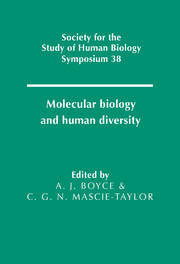Book contents
- Frontmatter
- Contents
- List of contributors
- Preface
- 1 Mitochondrial DNA in ancient and modern humans
- 2 Digital DNA typing of human paternal lineages
- 3 Minisatellites as tools for population genetic analysis
- 4 DNA fingerprinting: development of a technology and its application to the study of human populations
- 5 Kinship, inbreeding, and matching probabilities
- 6 Using the coalescent to interpret gene trees
- 7 Some attempts at measuring natural selection by malaria
- 8 AIDA: Geographical patterns of DNA diversity investigated by autocorrelation statistics
- 9 Mitochondrial DNA sequences in Europe: an insight into population history
- 10 Palaeolithic and neolithic contributions to the European mitochondrial gene pool
- 11 The molecular diversity of the Niokholo Mandenkalu from Eastern Senegal: an insight into West Africa genetic history
- 12 The peopling of Madagascar
- 13 Molecular perspectives on the colonisation of the Pacific
- 14 Population ancestry on Tristan da Cunha–the evidence of the individual
- 15 Linguistic divergence and genetic evolution: a molecular perspective from the New World
- 16 Allelic sequence diversity at the human β-globin locus
- 17 A nuclear perspective on human evolution
- 18 Contrasting gene trees and population trees of the evolution of modern humans
- 19 Methods and models for understanding human diversity
- Index
10 - Palaeolithic and neolithic contributions to the European mitochondrial gene pool
Published online by Cambridge University Press: 19 September 2009
- Frontmatter
- Contents
- List of contributors
- Preface
- 1 Mitochondrial DNA in ancient and modern humans
- 2 Digital DNA typing of human paternal lineages
- 3 Minisatellites as tools for population genetic analysis
- 4 DNA fingerprinting: development of a technology and its application to the study of human populations
- 5 Kinship, inbreeding, and matching probabilities
- 6 Using the coalescent to interpret gene trees
- 7 Some attempts at measuring natural selection by malaria
- 8 AIDA: Geographical patterns of DNA diversity investigated by autocorrelation statistics
- 9 Mitochondrial DNA sequences in Europe: an insight into population history
- 10 Palaeolithic and neolithic contributions to the European mitochondrial gene pool
- 11 The molecular diversity of the Niokholo Mandenkalu from Eastern Senegal: an insight into West Africa genetic history
- 12 The peopling of Madagascar
- 13 Molecular perspectives on the colonisation of the Pacific
- 14 Population ancestry on Tristan da Cunha–the evidence of the individual
- 15 Linguistic divergence and genetic evolution: a molecular perspective from the New World
- 16 Allelic sequence diversity at the human β-globin locus
- 17 A nuclear perspective on human evolution
- 18 Contrasting gene trees and population trees of the evolution of modern humans
- 19 Methods and models for understanding human diversity
- Index
Summary
Introduction
Mitochondrial DNA (mtDNA) variation has been used extensively for examining large-scale questions of human evolution, population structure and demographic history (Cann, Stoneking & Wilson 1987, Vigilant et al., 1991). Recently, however, the ability of mtDNA to resolve the close genetic relationships within relatively homogeneous populations such as the Europeans has been questioned (Bertranpetit et al., 1994; Pult et al., 1994). Using a new phylogenetic method we believe, on the contrary, that it is possible to reveal considerable structure within Europe and, by comparing geographical affinities and divergences between groups of mitochondrial lineages, examine different hypotheses about European colonization.
Mitochondria are maternally inherited and non-recombining, and the effectively haploid genome accumulates mutations faster than nuclear DNA. The most variable region of the mitochondrial genome is the 1122 bp non-coding control region between bp 16024 and 00576 (numbering after Anderson et al., 1981) within which the variation is concentrated in two regions (I and II) (Stoneking et al., 1991). As a population genetics method it differs from allele-frequency based surveys of nuclear encoded variants in several respects: i) the variation is very extensive and is not scrambled by recombination; ii) the effective population size is roughly one quarter that for nuclear variants which enhances the effect of drift; iii) being maternally inherited, only female lineages are relevant; iv) deducing the phylogenetic relationships within and between haplotype clusters is relatively straightforward and allows divergence and expansion times to be estimated.
- Type
- Chapter
- Information
- Molecular Biology and Human Diversity , pp. 130 - 140Publisher: Cambridge University PressPrint publication year: 1996
- 2
- Cited by



